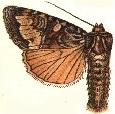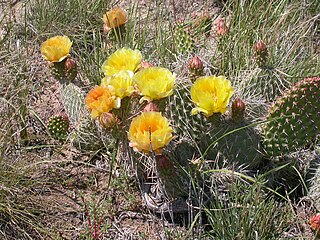
Cactoblastis cactorum, the cactus moth, South American cactus moth or nopal moth, is native to Argentina, Paraguay, Uruguay and southern Brazil. It is one of five species in the genus Cactoblastis that inhabit South America, where many parasitoids, predators and pathogens control the expansion of the moths' population. This species has been introduced into many areas outside its natural range, including Australia, the Caribbean, and South Africa. In some locations, it has spread uncontrollably and was consequently classified an invasive species. However, in other places such as Australia, it has gained favor for its role in the biological control of cacti from the genus Opuntia, such as prickly pear.
Afotella is a monotypic moth genus of the family Noctuidae erected by William Barnes and Foster Hendrickson Benjamin in 1926. Its only species, Afotella cylindrica, was first described by Augustus Radcliffe Grote in 1880. It is found in western North America from Saskatchewan and Alberta south to California.

Andropolia aedon is a moth in the family Noctuidae first described by Augustus Radcliffe Grote in 1880. It is found in North America from British Columbia and Alberta south to California.

Apamea occidens, the western apamea, is a moth of the family Noctuidae. The species was first described by Augustus Radcliffe Grote in 1878. It is native to western North America as far east as Alberta and Kansas.

Globia subflava, the subflava sedge borer or yellow sedge borer, is a moth of the family Noctuidae. The species was first described by Augustus Radcliffe Grote in 1882. It is found in North America from Nova Scotia west to British Columbia, south to New Jersey in the east and Utah and California in the west.

Schinia nuchalis, the spotted sage moth, is a moth of the family Noctuidae. The species was first described by Augustus Radcliffe Grote in 1878. It is found from the Great Plains and Great Basin, from southern Saskatchewan, Alberta and British Columbia south to northern Arizona. The Eurasian Schinia scutosa is no longer considered a synonym of Schinia nuchalis.
Photedes defecta, the narrow-winged borer, is a moth of the family Noctuidae. The species was first described by Augustus Radcliffe Grote in 1874. It is found in North America from Maryland and Massachusetts north to New Brunswick, west to North Dakota and British Columbia.

Acronicta lupini, the lupine dagger or little bear, is a moth of the family Noctuidae. The species was first described by Augustus Radcliffe Grote in 1873. It is found from Quebec, Newfoundland and Labrador, British Columbia, Alberta and Yukon in Canada, south to California.
Copablepharon longipenne, the dusky dune moth, is a moth of the family Noctuidae. The species was first described by Augustus Radcliffe Grote in 1882. It is found in North America from south-western Manitoba to southern Alberta, south to western Texas.

Euxoa albipennis is a moth of the family Noctuidae first described by Augustus Radcliffe Grote in 1876. It is found from coast to coast in southern Canada and the northern parts of the United States, ranging southward in the west to New Mexico, Arizona and California.
Macrochilo bivittata, the two-striped snout-moth, is a litter moth of the family Erebidae. The species was first described by Augustus Radcliffe Grote in 1877. It is found from the Atlantic coast west across the parklands and southern boreal forest of North America to central Alberta, south to Massachusetts and Ohio.
Melitara prodenialis is a moth of the family Pyralidae described by Francis Walker in 1863. It is native to North America, where it is known from south-eastern New York to Florida along the Atlantic coastal plain, and west to eastern Oklahoma and north-central and south-eastern Texas. It is an introduced species in Hawaii. It is a special concern species in Connecticut.

Dioryctria auranticella, the ponderosa pineconeworm moth, is a moth of the family Pyralidae. The species was first described by Augustus Radcliffe Grote in 1883. It is found in western North America from southern British Columbia south to California and Arizona, east to South Dakota and New Mexico.

Opuntia polyacantha is a common species of cactus known by the common names plains pricklypear, starvation pricklypear,. and hairspine cactus, panhandle pricklypear. It is native to North America, where it is widespread in Western Canada, the Great Plains, the central and Western United States, and Chihuahua in northern Mexico. In 2018, a disjunct population was discovered in the Thousand Islands region of Ontario, Canada.

Melitara is a genus of snout moths in the subfamily Phycitinae. It was described by Francis Walker in 1863. Some sources list it as a synonym of Zophodia, while others retain it as a valid genus.
Melitara texana is a species of snout moth in the genus Melitara. It was described by Herbert H. Neunzig in 1997 and is found in southern Texas and adjacent Mexico.
Melitara doddalis is a species of snout moth in the genus Melitara. It was described by Harrison Gray Dyar Jr. in 1925, and is found in the United States in southern Arizona, southern New Mexico, south-western Texas and in northern Mexico.
Melitara junctolineella is a species of snout moth in the genus Melitara. It was described by George Duryea Hulst in 1900. It is found in southern Texas and Mexico. The species has been introduced in Australia as a biological control agent of Opuntia stricta.
Melitara subumbrella is a species of snout moth in the genus Melitara. It was described by Harrison Gray Dyar Jr. in 1925. It is widespread in western North America, from southern Alberta and Saskatchewan to southern Arizona, central Texas, southern New Mexico and south-eastern California.

Dicymolomia julianalis, or Julia's dicymolomia moth, is a moth of the family Crambidae. It is found in most of eastern North America and on Cuba.










